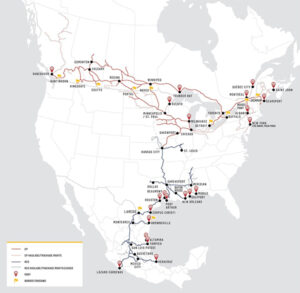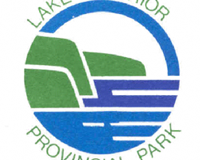
Combined Network Map: Creating the First U.S.-Mexico-Canada Rail Network (CNW Group/Canadian Pacific)
Beware of Canadian railway wolves in sheep’s clothing. Two have been circling the Kansas City Southern Railway (KCS) since early 2021 and one is now getting ready to dine – it thinks.
The two northern wolves are our transcontinental railways, Canadian Pacific (CP) and Canadian National (CN). In their prime, both were powerhouses that spanned Canada, served U.S. border regions, and glazed their rail accomplishments with a dazzling icing of complementary travel, transportation, and communications services. In CP’s case, it girdled the globe with its White Empress steamships and an international airline. Under the direction of Illinois-born Sir William Cornelius Van Horne, it was solidly built to become a juggernaut that proudly flew Canada’s flag worldwide.
CN was fused together from a series of publicly-owned and bankrupt private railways by Sir Henry Thornton, an Indiana-born railroader who crafted it into a serious competitor of privately-owned CP. The pride of Canadians for generations, the aptly-named People’s Railway was privatized by the Government of Canada in 1995; many Canadians wept at the loss of this valuable public policy resource.
But that was then and this is now.
Today, these two once-great Canadian railways – like most of America’s railways – have been diminished by various managerial decisions through the years and most recently by a self-inflicted concept disingenuously labeled precision scheduled railroading (PSR). It was spawned at CN by Memphis-born E. Hunter Harrison, who died in 2017 after implementing it there, on rival CP next and finally on CSX in the eastern U.S. As has become alarmingly apparent, PSR has little to do with running a precision scheduled railroad.
PSR has been a means for Class I railroads to rip up track, shut down yards, reduce train frequency and slash employee head counts to boost stock prices and dividends. It operates monstrously long trains that don’t mesh with the stripped, inadequate infrastructure. This plays well with the investment community, but certainly not shippers or the passengers whose trains must tread the tracks of these freight railways.
Slipshod service and the underlying pursuit of increased dividends are now drawing the fire of government regulators. U.S. Surface Transportation Board (STB) Chairman Martin Oberman recently said, “Since 2006, our economy has grown by more than 50 per cent … and yet railroads are carrying less freight today than they were in 2006 while rates have gone up. There just might be a connection.”
America’s largest and most accomplished railway, Burlington Northern Santa Fe, has rejected the PSR fantasy, but KCS has belatedly fallen for this investor-driven genie, importing two former CN executives to implement it. They say their PSR 2.0 is a much improved version, but that remains to be seen.
If the newfangled KCS version of PSR is anything like the original, watch out, especially since CP is crowing about how it intends to aggressively pursue it on a combined CP-KCS system. I see the results of PSR daily in the CP and CN delay reports I receive on their freight trains and the VIA passenger trains on their tracks. Transcontinental freight and passenger trains that arrive in Toronto or Vancouver 10, 12, or even 24 hours late are routine.
This PSR madness and other points need to be considered before the STB and the Canadian and Mexican regulators allow KCS to become CP’s dinner. KCS is a lynchpin of North American railroading, running down the center of the continent to connect the Midwest, the Gulf Coast, and Mexico. It is perhaps North America’s most strategic railway. And if this merger goes through, it will trigger a feeding frenzy that will ultimately leave North America with only two major railways serving all three countries.
Welding KCS to CP may make sense on a map – as would its combination with any other major railway. But it’s a risky proposition when one considers the damage that continues to be inflicted on CP shippers and passengers today under PSR.
There is a need for the Canadian, American, and Mexican regulators to hit the pause button and ponder the words of legendary railroader Leonor F. Loree, a fixer of sick railroads. When he was asked to examine the unhealthy KCS of 1906, he said, “This is a helluva way to run a railroad.”
Allowing CP in its current state to couple on to today’s healthy KCS may cause those words to resonate again, when yet another corporate train wreck comes lumbering down the track.
- The Great Train Robbery – Part 2 - June 12, 2023
- The Great Train Robbery – Part 1 - March 19, 2023
- Railroaded: A National Train Wreck - February 3, 2023
 Wawa-news.com You can't hear the 'big picture'!
Wawa-news.com You can't hear the 'big picture'!


